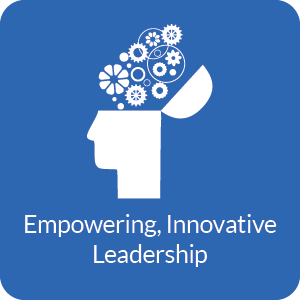Gear 3 - Introduction
Innovative leadership has the opportunity to inspire change, support risk-taking and communicate expectations of use through curriculum, goals and outcomes for all learners. Gear 3 is comprised of the following Future Ready Framework collaborative leadership elements:

- A Shared, Forward-Thinking Vision for Digital Learning
- A Culture of Collaboration, Innovation, Capacity Building, and Empowerment
- High Expectations for Evidence-Based Transformations to Digital Learning
- Transformative, Coherent Thinking, Planning, Policies, and Implementation
Leadership demands the effective and efficient use of data. The Wisconsin Information System for Education (WISE) is comprised of multiple tools supporting data collection to meet all required district and school state and federal reporting mandates. These data then inform education research and data analysis through dashboard and reporting tools to better understand and improve educational outcomes for Wisconsin students. This system promote data quality and establish security policies and standards to ensure data privacy. Multiple stakeholders include educators, district and school officials, and DPI staff can this system. Specific tools, such as the WISEdash Public Portal, are available for parents and community members. Empowered leaders at all levels will find this resource invaluable to make data-informed decision.
Gear 3 - Guiding Questions for Planning
- Have districts set clear expectations as to what is expected of staff and students in implementing the vision for digital learning?
- Is progress toward a digital learning plan being monitored, reported on, and used to inform decision making?
- Do educators have the skills to adopt and adapt to new technologies in a way that adds value to the learning process and close achievement gaps?
- Are educators sharing their progress with parents and the community?
- Have leaders developed internal metrics to track progress toward the vision and a strategic plan?
Gear 3 - Empowering, Innovative Leadership Priorities
The Wisconsin Digital Learning Plan Goals, Recommendations, and Priority Activities within each section of the plan represent issues that speak to our engagement with federal, state, and local education agencies. Activities are targeted for completion by state education agency (SEA) and local education agency (LEA). In many cases, there will be collaboration between and among agencies to meet the goals.
GOAL 3.1
Utilize leaders at all levels to implement, monitor, adjust, and incrementally improve digital learning in Wisconsin.
RECOMMENDATION
Encourage districts to create digital resource plans including updated actions, behaviors, and policies supporting the technical, physical, and adaptive changes needed to personalize learning for students and professionals.
PRIORITY ACTIVITIES
- Create a process to be replicated across districts that engages students, teachers, administrators, parents, and the community to envision a transformed education system personalizing learning for all students through the effective uses of technology. (SEA Target for Wisconsin DPI)
- Offer state and regional training to school districts as they create their integrated library media and technology plans. (SEA Target for Wisconsin DPI)
- Review current federal, state, and district policies to ensure alignment with the vision for a digital learning environment. (LEA Target for districts)
GOAL 3.2
Develop and implement digital learning competencies for teachers, administrators, students, technical staff, and support staff.
RECOMMENDATION
Ensure teachers, administrators, students, technical staff, and support staff can demonstrate understanding and application of the digital learning competencies.
PRIORITY ACTIVITIES
- Establish a set of metrics for measuring the progress of a school district’s digital learning implementation effort, and provide state and regional professional development in the use of such metrics. (SEA Target for Wisconsin DPI)
- Showcase Wisconsin districts which have made evidence-based transformations to digital learning. (SEA Target for Wisconsin DPI)
- Create a culture of trust to provide opportunities to empower educators to innovate and sustain change. (LEA Target for districts)
GOAL 3.3
Establish a collaborative culture of capacity building and empowerment in which leaders are encouraged to innovate.
RECOMMENDATION
Provide leaders with flexibility and adaptability to encourage innovation.
PRIORITY ACTIVITIES
- Establish a partnership with educational leader representatives from state professional organizations (for example, Wisconsin Association of School Boards (WASB), Wisconsin Association of School District Administrators (WASDA), Wisconsin Association of School Business Officials (WASBO), Association of Wisconsin School Administrators (AWSA), CESA Statewide Network (CSN) and the Wisconsin Association of School Curriculum Directors (WASCD) as well as post-secondary institutions to share research on innovation and collaborative leadership leading to sustainable change. (SEA Target for Wisconsin DPI)
- Collaborate with WASDA and the AWSA to create Wisconsin Digital Leadership competencies aligned to the Future Ready framework. (SEA Target for Wisconsin DPI)
- Provide avenues for ongoing communication of current research to inform all digital transformations. (SEA Target for Wisconsin DPI)
- Showcase Future Ready and Wisconsin Technology Initiative (WTI) districts which support and enhance leadership in digital learning environments. (SEA Target for Wisconsin DPI)
- Work collaboratively with teachers and principals to develop a tool to be used within the Effective Educator system reflecting a transformational digital teaching and learning environment. (SEA and LEA Targets for Wisconsin DPI and districts)
GOAL 3.4
Communicate a shared vision for digital learning to a broad audience including parents, students, school board members, and community stakeholders.
RECOMMENDATION
Create strategic communication plans for multiple audiences to ensure the adoption of the digital learning vision.
PRIORITY ACTIVITIES
- Provide state and regional training to assist districts in the creation and communication of their vision for digital learning. (SEA Target for Wisconsin DPI)
- Set clear expectations as to what is expected of staff and students in implementing the vision for digital learning both in and out of school, and communicate this broadly with students, staff, parents, and other community stakeholders. (LEA Target for districts)